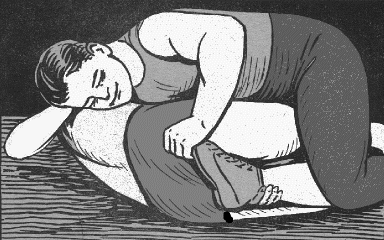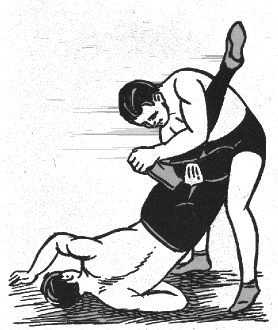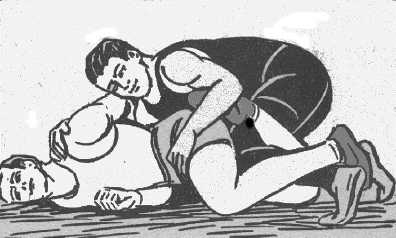The Toehold
as taught by Frank Gotch
Frank Gotch is considered by many wrestling historians to be the greatest Catch Wrestler to ever step into the ring.
George Robbins, of The Sporting Staff of The Chicago Daily news, once said "There are four requirements of a great wrestler who can keep a title for years without having his shoulders pinned to the padded canvas: Strength, endurance, speed and skill. Probably no man in the annals of wrestling has had these elements so mingled in him in the proper proportions as Frank Gotch."
He was America's greatest in the sport's greatest era, and the Toe Hold was his best known hold.
Here he teaches the Toe hold and some variations in an excerpt from the 1923 book HOW TO WRESTLE, INSTRUCTIONS OF FRANK GOTCH
Gotch's Famous Toe Hold

Gotch's Famous Toe Hold (Above) |
| |
| I have been often asked how and when I discovered the toe hold. That is a pretty hard question. Farmer Burns and I worked out the problem of the toe hold wrestling in Iowa. I think I used it first on Scott Miller. I pulled the foot over the leg and applied leverage. The other toe hold, and the one I employ the most, was worked out later. |
| There are several varieties of toe holds and locks, but the one I use the most and the one the writers call "the famous toe hold," consists of getting the opponent's foot in a vise in which the toes and ankle are the points of the attack. It is often confused with the toe hold over the leg, but the two grips are distinct. |
| It is important first of all to have one's opponent in the proper position to begin the preliminary moves for the toe hold. When an opponent is on the mat, suppose the attacker is on the right side. The wrestler who is the "under dog" must be on his hands and knees for the attacker to make the shift that traps his opponent's further foot. |
| The attacker from this position holds his opponent to the mat by grasping the right leg high up with both hands, working well to the side. With his right hand the attacker reaches inside the crotch from the front, grasping his opponent's left ankle. With the left hand he grasps his opponent's foot near the toes, almost simultaneously straddling the near leg of his opponent and pulling up on the imprisoned foot. The opponent's right leg in this way is trapped and his left foot is "out of commission." When the left leg has been imprisoned in this way for a few seconds, the muscles relax and the member becomes powerless. The attacker then pulls up and may apply the twist to the toe hold. His head may be used as an instrument of attack in forcing an opponent's shoulders to the mat. |
| Since the left leg of the defensive wrestler has become ineffective by being imprisoned in this way, the ankle hold may be released and the toe hold easily retained. The free right hand of the attacker then may be used in forcing the shoulders of the defensive wrestler to the mat. Since the under wrestler has turned on his side, the half nelson may be affixed and the opponent pinned with the half nelson and the toe hold or the toe hold released and the crotch and nelson applied. The toe hold may be used alone. |
The Toe and ankle Hold

Toe and Ankle Hold (Above) This combination hold is secured when the wrestlers are on the mat. While working on the right side, the left foot of the defensive grappler is drawn up. The attacker slides under the right leg of his opponent holding the toe grip. The defensive wrestler is raised up of the mat, the attacker reaches under with his right hand and grasps the imprisoned left ankle completing the hold. In this position the least twist is painful and the defensive wrestler will gladly succumb.
The Toe Hold Over The Leg

Toe Hold Over the Leg (Above)
When I was in England trying to force Hackensmidt out of his shell, I was asked quite often to explain the toe hold.
A sporting writer asked me whether I thought it right to use such a painful grip. He said it was against the rules to twist a wrestler's finger and it was certainly just as unfair to twist one of his toes. To have answered that question would have spoiled a good joke, but it expresses the general idea of the toe hold, which is an erroneous one.
One day when I had been wrestling in Cincinnati a newspaper man wanted me to show him how I secured the toe hold. I told him to get down on the floor and I would show him a touch of real life.
"Gotch bent over me," said this writer, "toyed a while with one of my feet, then quickly grabbed the other and gave it a twist. I looked for a nice clean spot on which to put my shoulders to keep my leg from snapping off. I wanted the leg for future use. It felt as though Gotch wanted to take it along with him. At that he exerted only a few pounds of pressure."
This writer had caught the principle idea of toe hold--- the idea of leverage. I made a study of the mechanics and it was there that I learned the true value of leverage in wrestling.The plan of this and other such holds is to make one's opponent use many times more power to resist one than the attacker exerts in his aggressive moves. I have wrestled stronger men than I am, but in every move I try to make my opponent use more strength than I do. in this way he tires much quicker. He is fighting himself and his opponent much of the time.
The defensive wrestler must be on his hands and knees on the mat in order to work the toe hold over the leg. An opponent may lie flat on the mat of his own accord and if he refuses to take this means of resting up, he may be forced down by superior strength or by suddenly raising him by the near leg and lunging him forward.
In this position the attacker straddles and sits on the near leg of the defensive wrestler above the knee. He feints for the further foot of his opponent. When the defensive wrestler shifts to protect his foot, the near one may be grasped quickly and raised up over the attacker's leg.
This plunges the head of the defensive wrestler forward on his face. It brings his weight to bear on his own imprisoned leg in such a way as to make him share in the leverage that is exerted by the completed hold.
The imprisoned leg should be drawn up as high as possible to give the longest leverage, in which it is possible for a small man to hold a giant. This works on the same principle as the handle of a pump. A small child may grasp the end of a pump handle and make it work, but it would take a strong man to grasp the handle near the top and bring a blow of aqua pura.
There seems to be a movement in some quarters to bar the toe hold in championship matches. Well, I won't mourn its loss if the grip has to go, but I think it has a rightful place just as certainly as the headlock, hammerlock and several forms of the wrist lock. I probably would have won every match that went to my credit if the toe hold had been barred. with the toe hold over the leg, to which the principle objection is made, I have won a small portion of my matches. Donelson, Rooney, Raoul De Rouen, Harrington and Grant are a few on whom I have affixed toe holds and won. I defeated most of my opponents, however, with other grips.
In grasping the foot to pull it over the leg, the attacker should catch it just below the toes. The attacker usually discovers that the muscles of the leg are relaxed, showing the defensive wrestler was off his guard.
The Bar and Toe Lock

The Bar and Toe Lock (Above) In this combination the attacker proceeds as in getting the toe hold over the leg. When this toe hold is secured, the aggressor suddenly shifts the imprisoned foot from the left hand, if working that way, to the joint of the left arm, at the same time crawling forward and applying the bar hold with the right hand as in the illustration. --- Frank Gotch
Hope you learned alot from this, and I hope it adds to your training! Don't forget that the toe hold is a much more dangerous hold than it looks! PRACTICE IT CAREFULLY with respect for your training partners. Don't forget that Frank Gotch BROKE the legs of a couple of his opponents in matches with these holds!
--- Jim Olsen



